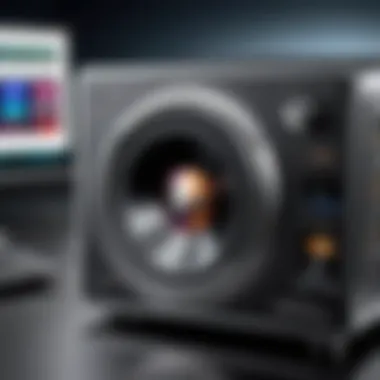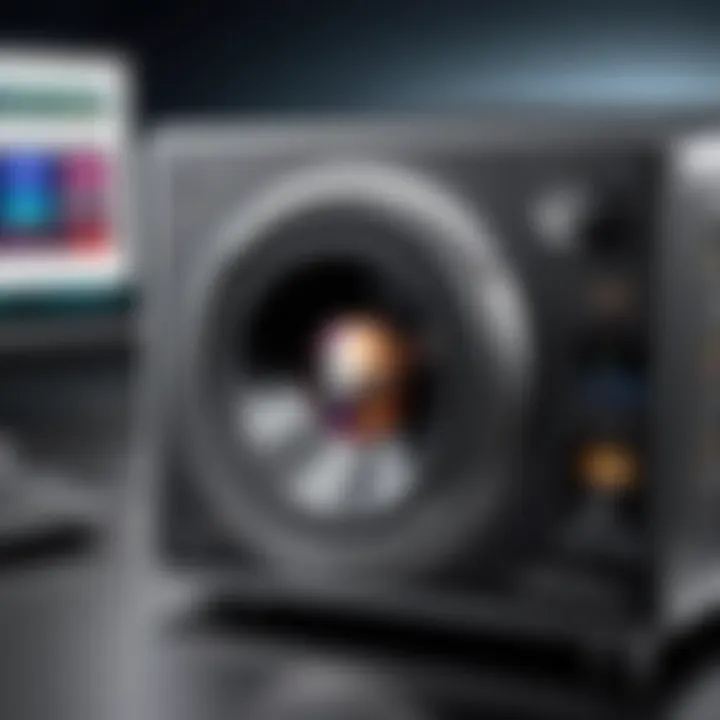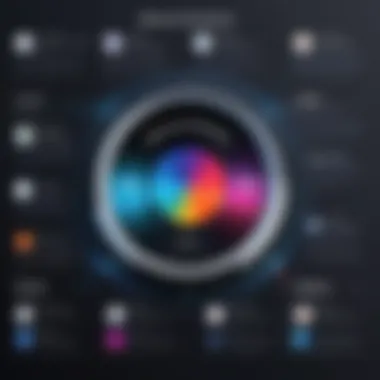A Comprehensive Guide to Music Players for PC


Intro
In an age where music is just a click away, having the right tools to enjoy your favorite tunes is essential. Much like a chef needs high-quality knives, a music enthusiast requires robust music players to get the most from their audio collection. Whether you're a vinyl aficionado or you prefer streaming the latest hits, picking the right software can make all the difference.
Exploring the realm of music players on personal computers isn't just a mere dabb; it’s an adventure. The options available range from well-known giants to hidden gems, each offering a unique flair and functionality. Let's delve deeper into the technology that powers these players, keeping in mind that every feature could affect how music resonates through our speakers.
Overview of the Technology
When we talk about music players, a few key specifications jump to the forefront. Supported audio formats, ease of use, and customizability are the bedrocks of a quality player. If you want to ensure you're experiencing sound as it was intended, compatibility with high-resolution audio formats is a vital consideration. Players like Foobar2000 and AIMP cater to those who crave flexibility, allowing for an array of file types, from MP3 to FLAC.
Key specifications
- Audio Format Support: Ensure the player can handle various formats, from MP3 to lossless audio.
- User Interface: A clean and intuitive interface can significantly enhance usability. Look for features that keep the experience streamlined.
- Extensibility: Some players, such as VLC Media Player, offer add-ons that can expand functionality.
Unique selling points
- Customization Options: MusicBee allows for extensive skinning and layout customization, making your interface as unique as your music taste.
- Library Management: MediaMonkey excels in managing large libraries effortlessly, a boon for avid collectors.
- Streaming Integration: Players like Plex add streaming capabilities, giving access to vast libraries while still retaining local media playback.
Design and Build Quality
Often overlooked, the design and build of a music player can influence its day-to-day usability. This aspect is especially important given how much time one might spend navigating through music libraries.
Material used
The materials that frame the player’s interface—although they may signal quality—primarily impact durability over aesthetics. Players made with lightweight materials are easier to navigate; however, those with sturdier builds often last longer.
Ergonomics and usability
Crucially, you want to make sure your tools fit comfortably into your routine. A good player has buttons and menus that feel right to the touch, with options that are easy to find. That said, if too much time is spent searching for features, the experience can quickly become frustrating.
"Choosing a player isn't just about looks—it's about how it makes you feel while you listen."
Final thoughts
As we explore these music players, remember, your choice hinges greatly on your listening habits and preferences. Are you a stickler for quality? Or do you appreciate intuitive navigation? The balance between these elements defines your overall experience. As we move into the more practical side of audio players, we will also tackle how the rise of streaming has transformed the landscape of traditional music playback.
Understanding Music Players
In the realm of digital entertainment, music players stand as pivotal tools that have transformed how we enjoy sound. Understanding music players doesn't just boil down to knowing their basic functionality; it’s about unraveling the nuanced elements that enhance our listening experiences. Music players allow users to create, customize, and curate their auditory environment. With a myriad of options at our disposal, it’s essential to dive deeper into what defines these applications and how they cater to the diverse preferences of tech-savvy individuals.
One of the standout benefits of grasping the intricacies of music players is that it empowers listeners to tailor their experience according to their unique vibes. Whether it’s the sync of a beat or the sonic subtleties of an acoustic guitar strumming in a quiet corner, each player offers distinct features that can significantly affect our enjoyment. Moreover, these applications evolve continuously, keeping pace with technological advancements. This understanding allows users to make informed choices that not only optimize music playback but also align with their specific lifestyle needs.
Definition of Music Players
A music player is software that plays audio files on personal computers. Think of it as a digital jukebox, where users can store and manage their music libraries. It may seem straightforward, but the heart of a music player revolves around its ability to handle various audio formats—be it MP3, WAV, FLAC, or others. The definition expands beyond merely playing sounds; it’s about the experience it offers. An efficient music player does more than play tracks; it organizes the songs, allows for playlists, and sometimes provides visualization tools that create a more immersive experience.
Music players vary in complexity and target audience. While some are aimed at general users who want simple playback features, others cater to audiophiles who seek high-fidelity sound and in-depth customization.
The Evolution of Music Playback on PCs
Music playback on PCs has undergone a remarkable transformation since the advent of personal computing. In the early days, users were limited to basic functionality, with most music stored on CDs or cassette tapes. As technology advanced, the introduction of MP3 files revolutionized how we consumed music. With just a handful of kilobytes, entire albums could be stored and played in the digital space.
As software developed, so did user expectations. The rise of platforms like Winamp and iTunes marked significant milestones, allowing users not just to play music but also to engage with it—organizing libraries, creating playlists, and burning CDs. Eventually, streaming services shifted the landscape yet again. The convenience of accessing vast audio libraries at the click of a button became a game-changer in music consumption.
Today, the options are manifold. Users can choose from standalone applications, integrated media players, or browser-based options—each providing unique features that appeal to different types of music enthusiasts.
The evolution of music playback on PCs exemplifies how technology adapts to meet our varying needs. As we delve deeper into this article, we can see how understanding these players can significantly enhance our listening pleasure and fidelity.
Types of Music Players for PC
Understanding the types of music players that are available for personal computers is essential for anyone looking to optimize their audio experience. Each type has its own unique features and benefits, catering to different preferences and use cases. This section will explore three main categories: Standalone Music Players, Integrated Media Players, and Browser-Based Music Players. Whether you’re a casual listener or an audiophile, there’s a music player out there that fits your needs.
Standalone Music Players
Standalone music players are dedicated applications that allow users to play audio files without requiring other software to function. These programs are often highly customizable and can be optimized for performance and sound quality.
A prime example of a standalone music player is Foobar2000. It's designed with audiophiles in mind, providing various audio format supports and an ability to adjust settings to a user's liking. The user interface is quite minimal, but you can tweak it as you see fit.


Here are some characteristics of standalone players:
- Performance: They generally perform better since they are developed for a singular focus—playing music.
- Customizability: Most standalone players offer a wide range of plugins and skins to enhance user experience.
- Audio Format Support: They often support a plethora of audio formats, giving users flexibility in file types.
Despite their advantages, standalone players might require a steeper learning curve. Settin’ things up can sometimes feel like climbing a mountain for those who prefer straightforward interfaces.
Integrated Media Players
Integrated media players combine audiobook, video playback, and music into one package. This flexibility means you can rely on a single application for most media needs, eliminating the need to juggle multiple programs.
VLC Media Player is a classic example. It supports a wide variety of formats and codecs, making it a favorite among users. The good thing about integrated media players is their versatility. You can easily switch between watching a movie to listening to your favorite band without having to exit or load another application.
Key aspects of integrated players include:
- Ease of Use: They generally come with user-friendly interfaces that are easy to navigate.
- Multi-Functionality: Can handle videos, audio, and sometimes even streaming content.
- Community Support: Popular ones like VLC have strong community support, offering endless resources for troubleshooting.
However, they can occasionally lack some specialized features found in standalone players. Users who are purely music-oriented might find this integrated functionality a bit overwhelming, like trying to fit a square peg into a round hole.
Browser-Based Music Players
Browser-based players offer yet another convenient option for music enjoyment. They do not require installation, allowing instant access to your music library or streaming platforms from any device that has internet connectivity.
One popular browser-based music service is Spotify. With its ability to create playlists, explore new music, and listen to tracks with little hesitation, it has revolutionized the way we consume music.
The benefits of using browser-based music players include:
- Accessibility: You can listen to music on any device with a web browser, whether it’s a laptop, tablet, or smartphone.
- No Installation Needed: You can start listening right away, saving storage space on your PC.
- Social Integration: Many of these players offer social features, allowing you to share music or see what your friends are listening to.
On the downside, they may require a stable internet connection and can sometimes suffer from performance issues related to your browser’s capability. It’s like getting the best of a two-for-one deal, but if red flags pop up like loading times, it can dampen the experience.
Overall, each type of music player offers unique advantages. The best choice depends on personal preferences, system capabilities, and how much versatility you’re looking for.
Key Features to Consider
When diving into the vast world of music players for personal computers, it's crucial to focus on specific features that can profoundly affect the listening experience. These features dictate how well users can manage their libraries, listen to their favorite tracks, and personalize the functionality of the software. Let's look closer at the essential elements to consider when choosing the right music player.
Audio Format Support
Audio format support is a cornerstone feature that every music player must address. Support for various formats such as MP3, FLAC, WAV, and AAC can make all the difference in playback quality and flexibility. Different formats cater to different needs; for example, FLAC offers lossless audio, appealing to audiophiles who prioritize sound fidelity. On the other hand, MP3 is perfect for everyday listeners who value storage efficiency over perfect sound quality. Without robust format support, users may find themselves limited in their library choices or, worse, unable to play their favorite tracks at all.
Choosing a player that supports your preferred audio formats is pivotal to creating a seamless listening experience.
User Interface and Experience
User interface plays an essential role in how effectively one can enjoy their music. A cluttered or confusing interface can lead to frustration, detracting from the music experience. Features such as clear navigation, easy access to playlists, and search functionalities are important. An intuitive design tailored to the user’s needs enhances engagement and makes browsing through large libraries effortless. Look for players that offer customizable layouts; this way, users can tailor the interface to fit their unique taste. Well-designed software not only improves usability but also invites users to explore their music collection more deeply.
Library Management Tools
Managing a growing music library can be daunting without the right tools. Music players should come equipped with robust library management functionalities. Features such as tagging, album art support, and automated organization help streamline this process. For instance, the ability to sort songs by genre or create smart playlists based on listening habits can significantly enhance a user’s experience.
Furthermore, consider tools that offer backup options, ensuring that your entire music library is secured against unforeseen issues. In essence, great library management leads to a hassle-free experience where users can focus on enjoying their music rather than being bogged down by organizing it.
Customization Options
Customization has become a key feature that allows users to make an application uniquely theirs. Whether it's adjusting the color scheme, changing the layout, or configuring playback settings, options for personalization can create a more immersive experience. Moreover, music players that allow integration with plugins can expand functionalities even further. This aspect of music players is not just about aesthetics; it enables users to enhance their overall experience to meet their individual preferences. For example, a simple sound enhancer plugin can significantly upgrade how music is perceived through the system’s audio. Ultimately, the ability to customize ensures the software aligns closely with the user's lifestyle and preferences.
In this ever-evolving landscape of music players, considering these key features is vital to maximizing your audio experience. By focusing on elements like audio format support, user experience, library management, and customization options, tech-savvy individuals can make an informed choice that resonates with their personal preferences.
Popular Music Players Analyzed
Analyzing popular music players is crucial for any music enthusiast serious about their listening experience. Each player offers a distinct blend of features, compatibility, and user interface designs. This examination not only highlights the unique offerings of each player but also helps users identify their specific needs and preferences. When selecting a music player, understanding the benefits and drawbacks can significantly impact satisfaction levels in daily use, shaping how users interact with their audio library.
iTunes: Pros and Cons
iTunes has been a staple in the music player arena for years, primarily due to its seamless integration with Apple devices. Its pros include:
- Extensive Library: iTunes boasts a vast catalog of songs and albums for purchase or streaming.
- User-Friendly: Many find its interface straightforward, making it easy to navigate through large music libraries.
- Cross-Platform Use: Available on both Windows and macOS, making it versatile.
However, it does have cons worth mentioning:


- Resource Heavy: iTunes can be bogged down by heavy processing demands, making it sluggish on low-end PCs.
- Compatibility Issues: Not all audio formats are supported, which can frustrate users with diverse file types.
Media Player: Features Overview
VLC Media Player isn’t just a video player; it’s also a powerful music player that many overlook. One primary feature is its unmatched support for numerous audio formats. Beyond that, these additional features make VLC noteworthy:
- Open Source: It’s free to use and constantly updated by a community of developers.
- Lightweight: Designed to work efficiently even on older machines, VLC uses minimal resources, allowing for quicker playback.
- Advanced Playback Controls: Users can customize playback speeds, tag editing, and more, catering to diverse listening styles.
Foobar2000: A Deep Dive
Foobar2000 is often recommended for advanced users who prioritize customization. At its core, this player is built around flexibility. Some characteristics include:
- Highly Customizable Interface: Users can modify the layout, choose skins, and rearrange playlists as needed.
- Wide Format Support: It accommodates a plethora of format options, from standard MP3s to lossless types like FLAC.
- Smart Library Management: Foobar2000 excels in cataloging music, helping users manage their collections with ease.
Yet, its complex setup might not suit everyone, particularly those seeking a simple out-of-the-box experience.
Winamp: The Resurgence
Winamp has seen a nostalgic comeback, rekindling interest from early netizens. Its popularity stems from a few key elements:
- Modular System: Users can tailor their Winamp experience with plugins tailored for various needs, from audio enhancements to different visualization modes.
- Skins and Custom Themes: This flexibility allows users to personalize their music interface, enhancing their overall experience.
- Monitoring and Playback Features: Advanced users appreciate features like smart playlists and easy integration with online radio.
The new Winamp aims to blend its classic appeal with modern requirements, drawing in both old fans and newer tech-savvy listeners.
"A music player should feel less like software and more like a companion for every note and melody."
Emerging Players and Trends
The music player landscape for PCs is in a constant state of flux, driven by technology's relentless march forward. With traditional software solutions facing competition from newer options, understanding emerging trends is more crucial than ever. From the rise of streaming services to the need for compatibility with smart devices, these developments are shaping how we consume music today.
Rise of Streaming Services
Streaming services have stormed the gates, bringing with them a seismic shift in how people engage with music. Platforms like Spotify, Apple Music, and YouTube Music have not just become household names; they have redefined the music experience itself. Gone are the days of downloading albums or managing vast libraries of local files. The convenience of having access to millions of songs at your fingertips is a game-changer. This trend is not just a fleeting phase but fundamentally altering our consumption habits.
"The biggest change in music listening habits is not about what people listen to, but how they listen to it."
While one may argue about the loss of album-oriented listening, it's hard to deny the sheer accessibility that streaming offers. Playlists curated by algorithms can introduce listeners to new genres or artists they might never have discovered otherwise. Furthermore, the ability to share and collaborate on playlists fosters a communal experience, making music a shared journey rather than a solitary pursuit.
The Shift to Cloud-Based Solutions
Along with streaming services, we're seeing more music players embracing cloud technology, allowing users to store their libraries online. This transition makes it simpler to access personal music collections from any device without the hassle of transferring files. Cloud-based solutions not only bolster storage capabilities but also enhance accessibility and organization.
Imagine a situation where a user has various devices—PCs, tablets, even smart speakers—yet can play the same music library effortlessly across them all through a system like Google Drive or Dropbox. This flexibility eliminates the traditional constraints of hard drives and offers the functionality to manage music more efficiently. It ties in well with the increasing preference for mobility and constant connectivity amidst tech-savvy individuals.
Integration with Smart Devices
As the world leans towards smart homes and interconnected gadgets, the integration of music players with smart devices cannot be overlooked. Devices like Amazon Echo or Google Nest have ushered in an era where music is just a voice command away. The synchronization between these smart speakers and music players allows for a fluid listening experience. Imagine asking your device, "Play my favorite jazz playlist," and having it seamlessly connect to your chosen music player, whether it's from a streaming service or your personal library.
These integrations not only enrich user interaction but also reflect broader trends in technology toward smart living. The ease of voice control and smart assistant features makes it simpler for users to dive into their favorite audio worlds without the fuss of navigating complicated interfaces.
Performance Considerations
When delving into the world of music players on personal computers, the performance considerations stand as a critical pillar that can make or break the listening experience. It's not just about which application you choose; it's also about how well that application works within the ecosystem of your system's specifications and audio output quality. Understanding these nuances is essential for any tech-savvy individual looking to enhance their audio engagement.
Effects of System Specifications
The vital relationship between a music player’s performance and your computer’s specifications cannot be understated. In the same way a high-performance sports car requires quality parts to reach top speeds, a robust music player demands a well-equipped PC to deliver pristine audio.
Key aspects of system specifications to consider include:
- Processor Power: A faster processor can handle complex audio decoding tasks more efficiently. For instance, if you're using a player like Foobar2000 with high-resolution audio formats, a solid CPU ensures seamless playback.
- RAM Capacity: Increased RAM can improve multitasking capabilities, especially if you’re running additional applications while listening. Enough memory guarantees smoother transitions and loading times.
- Storage Speed: Solid State Drives (SSDs) typically offer faster read speeds, which helps when accessing large music libraries without lag. Think about the frustration of waiting for your favorite song to load.
- Graphics/GPU: While not directly related to audio, a good GPU can offload tasks from the CPU, potentially free up resources for enhanced audio processing, particularly in integrated players that also handle video.
A balanced combination of these factors leads to a smoother experience where your music player runs efficiently, and audio output isn’t hampered by system limitations.
Quality of Audio Output
Once you've got an efficient configuration, the next layer is the quality of audio output. Even the fanciest music player can’t shine if the sound quality is less than stellar. Several factors influence audio output quality:
- Digital-to-Analog Converter (DAC): The DAC converts digital signals to analog audio. A higher quality DAC can make a world of difference. For example, using external high-grade DACs often enhances the listening experience significantly.
- Bit Depth and Sample Rate: The depth and rate at which audio is processed are crucial. Higher bit depths and sample rates allow for more detailed audio, making nuances clearer. Many audiophiles swear by 24-bit audio files for this reason.
- Sound Card Quality: A decent sound card eliminates unwanted noise and distortion, ensuring your tunes are as crisp as they should be. Integrated sound cards may cut it for casual listeners, but serious audio enthusiasts would benefit from dedicated sound cards.
- Audio Format: Different music files (like MP3 vs. FLAC) carry distinct qualities. Compressed formats can sacrifice quality. If your goal is to enjoy the full fidelity of recordings, why settle for an inferior format?


"An audiophile doesn't just hear music; they feel it in their bones. Quality equipment allows every note to resonate with clarity."
To summarize, understanding both system specifications and audio output quality shapes the overall experience of using a music player on a PC. It goes beyond the simple act of playing a song; it’s about making sure every song sounds the way the artist intended, with the emotions intact and the details undisguised. By diving into these factors, listeners can find that perfect harmony in their music experience.
Setting Up a Music Player on PC
Setting up a music player on your PC is more than just about hitting "install." It’s a crucial step that shapes how you will experience your music. A well-configured music player can not only provide a better audio output but also enhance your overall user experience. You might think all players operate the same way, but there's a world of distinct options out there, crafted for various listening styles and preferences. Understanding how to set your player up properly ensures that you don’t miss out on the features it comes with.
By taking the time to set up your music player right from the get-go, you can enjoy smoother playback, optimized sound quality, easy library management, and even customized interface options. It’s these details that can elevate your music enjoyment from a mundane task to an immersive experience.
Step-by-Step Installation Guides
Installing a music player generally follows a straightforward process. However, getting lost in the sea of options can sometimes be a hassle. Here’s a simple guide for some popular players. If you have any specific choice in mind, you may want to check its official site for detailed instructions.
- Download: Start by visiting the official website of your chosen music player. For instance, if you’re interested in VLC Media Player, head over to VLC's official site.
- Run Installer: Once downloaded, find the installation file in your downloads folder. Double-click to start the installation process.
- Follow Prompts: Follow the set-up prompts. Typically, it asks for agreement on terms and conditions and where you want to install the program.
- Additional Features: Some players offer optional add-ons or features during installation. Choose those according to your needs.
- Finish Up: After all configurations, the music player should be installed. Open it to check that it functions properly.
This guide gives a rough idea, but each player might have specific steps or additional tools to make the process easier.
Configuring Preferences for Optimal Use
Once your music player is installed, the next logical step is to configure your settings for the best performance. Going through preferences might feel tedious, but trust me, it's worth every second. That little bit of personalization can change how you interact with your music.
- Audio Quality Settings: Adjust settings to prioritize sound quality. For players like Foobar2000, you can set the output to various audio formats. This ensures that you enjoy your music as it was meant to be heard.
- Library Management: Import your music library by scanning directories. This is particularly effective if you’ve got a large collection. Make sure the player recognizes all your audio files.
- Interface Customization: These players often allow you to change the theme or layout. Finding an interface you like can make your experience much more pleasant.
- Keyboard Shortcuts: Learn the shortcuts the player offers. This will save you a lot of time browsing through your library while enjoying seamless interactions.
Setting up preferences may seem trivial, but optimizing your music player can make listening a more fun experience. Take the plunge, fiddle with the settings, and don’t be afraid to explore all functionalities it may offer.
"A well-configured music player is like a fine-tuned instrument; it delivers a performance that resonates with your soul."
In essence, setting up a music player on your PC is a multifaceted process. It's about making informed decisions right from installation to customization, enabling you to enjoy your favorite tracks in the manner they deserve.
Troubleshooting Common Issues
Troubleshooting common issues is an essential part of optimizing your music playback experience on PC. Problems with audio playback, library integrity, and operating system compatibility can disrupt enjoyment and reduce functionality. Addressing these issues not only ensures smooth performance but also enhances your overall listening experience. Here, we delve into three significant categories of issues that users often encounter:
Playback Problems
When it comes to music players, playback problems are among the most frequent complaints. These can manifest in several ways, such as stuttering audio, skipping tracks, or complete failure to play files. Such issues can stem from a variety of sources:
- Insufficient Resources: If your PC is bogged down with multiple processes running simultaneously, the music player may struggle to function properly.
- Audio Drivers: Outdated or corrupted audio drivers can lead to performance bottlenecks. Regularly checking for updates can save you a lot of headaches.
- File Format Issues: If the audio file is in a format that the player doesn’t support, it won't play at all. Always double-check file compatibility.
Addressing these playback problems starts with ensuring the system meets the necessary requirements and keeping software and drivers up to date. It's a good practice to close any background applications that may interfere with your music playback.
Library Corruption
Library corruption can mean the difference between a well-organized collection of music and a frustrating assortment of files that are hard to navigate. A corrupted library may result in missing tracks, duplicate entries, or incorrect metadata, creating chaos that most music enthusiasts dread. The causes of such corruption can include:
- Unexpected Shutdowns: Power outages or abrupt PC shutdowns while the music player is open can lead to corrupt library files.
- Improper File Handling: Moving or renaming music files outside of the application can confuse the music player, leading to a corrupted library.
To resolve library corruption, many music players come with built-in tools for library repair. Periodic backups of your music database can also provide a safety net. Troubleshoot carefully and consider scanning for errors before making drastic changes.
Compatibility with Operating Systems
Another critical issue is the compatibility of music players with different operating systems. Some players are designed to work seamlessly across various platforms, whereas others may have limited support. This could lead to confusion or, worse, non-functionality based on your system's specifications. Key points to consider are:
- Check Version Requirements: Always verify what versions of your OS the music player supports. For instance, not all applications run smoothly on Windows 11 yet, even if they function perfectly on older versions.
- Updates and Patches: Keeping both your operating system and music player updated is vital. Developers frequently roll out fixes that enhance compatibility and performance.
- Third-party Plugins: Sometimes, to ensure cross-compatibility, you may need to download additional plugins. This can add more functionality but also introduce another layer of troubleshooting.
The Future of Music Playback on Personal Computers
As technology barrels forward, the music playback landscape is experiencing transformative shifts that cannot be overemphasized. The advent of new technologies, consumer habits, and integration capabilities is reshaping how we experience music on personal computers. It’s not just about listening anymore; it’s about an entire ecosystem of sound. This section dives into important upcoming trends and the increasing role of artificial intelligence in music playback.
Predicted Trends in Music Technology
The music technology sector is in a state of rapid flux with trends that speak volumes about future direction. Here are some notable elements to keep an eye on:
- Rise of High-Resolution Audio: As internet speeds increase and bandwidth becomes less of a restrictive factor, high-resolution audio is no longer an obscure hobbyist's choice. Music enthusiasts are starting to embrace formats that provide greater detail and richness to sound, allowing for a more immersive listening experience.
- Seamless Integration: Personal computers are becoming central hubs for all media consumption. Music players that effortlessly sync with other smart devices such as smartphones and smart speakers are on the rise. Expect innovations that make it easy to switch between devices fluently, making the listening experience more cohesive than ever.
- Personalized Content Delivery: Recommendations based on artificial intelligence are predicted to become increasingly refined. User data will allow music players to suggest songs or artists that align closely with individual tastes, removing the need for endless searching.
- Interactive and Immersive Experiences: Virtual reality and augmented reality are set to add layers to music playback. Imagine attending a virtual concert right from your desktop, where the music feels as if it’s swirling around you in three dimensions.
"The way we listen to music is evolving, and technology is right at the heart of it; we are moving towards a phase where music becomes more than just sound, but an experience."
The Role of Artificial Intelligence
The application of artificial intelligence in music playback is arguably one of the most fascinating developments. Here are a few key considerations worthy of attention:
- Smart Playlists: With AI algorithms processing preferences, music players can generate playlists that adapt to your mood. Want something upbeat for your workout? Instantaneously, suitable tracks populate your library.
- Voice Command Integration: The incorporation of voice-assisted commands in music players is set to become more refined. Imagine just saying, "Play my favorite jazz," without lifting a finger – that’s the reality we are inching closer to.
- Innovative Problem Solving: AI can assist in troubleshooting common playback issues. If your favorite album won’t play, a smart algorithm might suggest possible fixes based on the nature of the problem and common trends in user behavior.
- Generative Music: Another captivating aspect of AI is its ability to create music. Tools that harness AI to compose original tracks are emerging, allowing users to generate sounds that fit their specific taste.
As we look at these dynamics, a future riddled with powerful possibilities presents itself. The relationship between personal computers and music playback continues to evolve, ensuring that every listening session is more than just hearing; it’s about connecting, experiencing, and enjoying on new levels.







